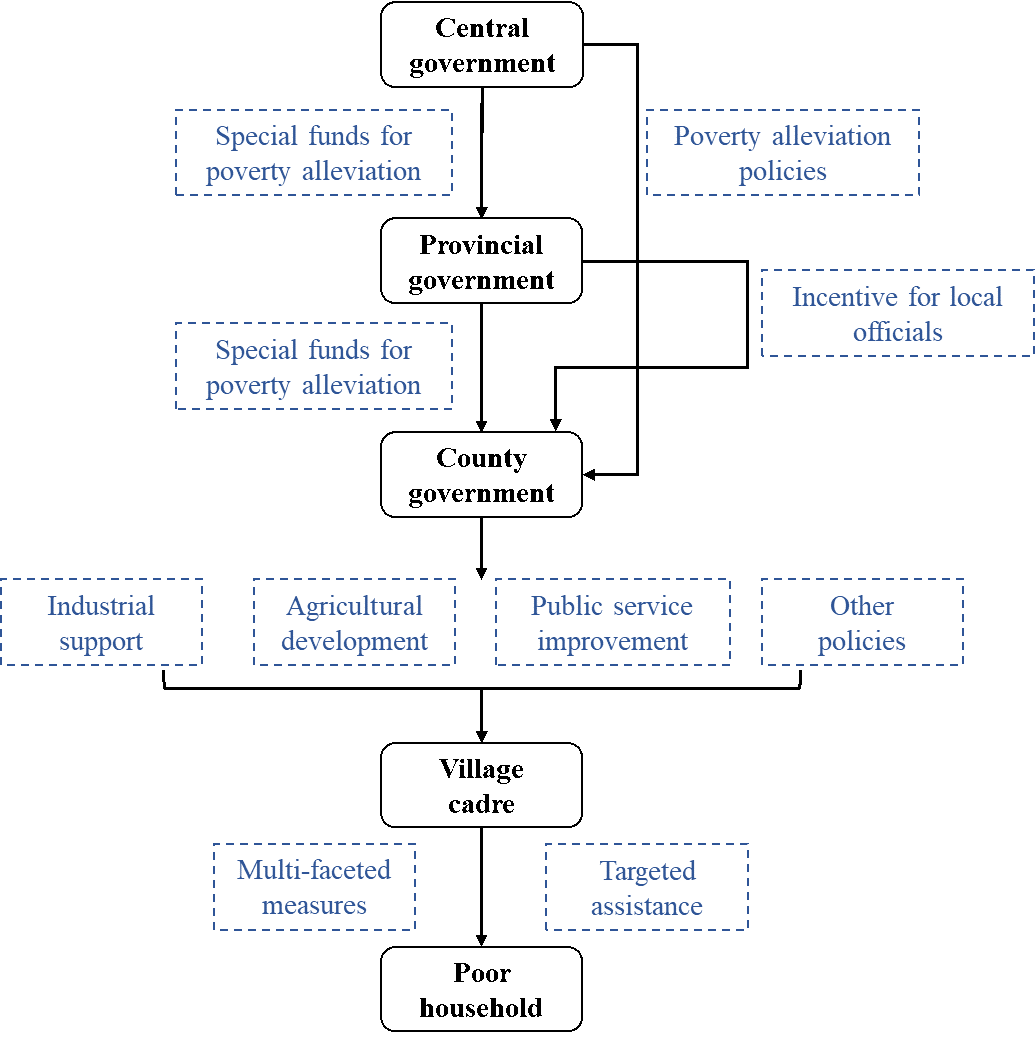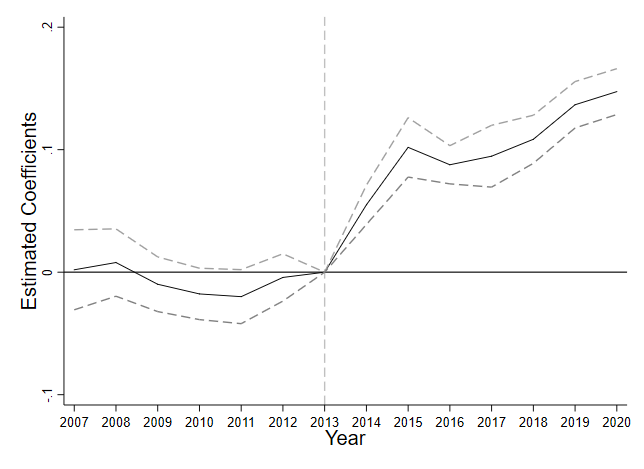The Effects of a Multifaceted Poverty-Alleviation Program on Rural Income and Household Behavior in China
This study examines the effects of a government-led, large-scale, multifaceted poverty-alleviation program on rural income in China. We find that the program has a positive impact on national key poor counties, with a 10.9% increase in rural income. This effect mainly arises via industrial support, agricultural development, and public service improvement. Strategies that are consistent with local comparative advantages and incentivize local officials to reduce poverty yield more significant effects. Household-level analyses suggest that the program changes household income and expenditure, and the effects are particularly substantial for the poorest households. The study provides novel insights and policy implications for China’s recent experience with poverty alleviation.

Of the 17 Sustainable Development Goals established by the United Nations, poverty reduction is at the top of the list. To achieve this goal, many developing countries have implemented various types of poverty-alleviation programs. Many studies have evaluated the effects of these programs, and the results are mixed.
As the largest developing country, China has achieved considerable success in poverty reduction. Over the past 40 years, the number of people in China with incomes below US$1.90 per day (the international poverty line) has fallen by close to 800 million. Thus, China accounts for almost 75% of the global reduction in the number of people living in extreme poverty (World Bank 2022). Many researchers have attempted to assess the effect of previous rounds of poverty reduction in China (Park and Wang 2010, Meng 2013), with only limited evidence on the most recent round of poverty-alleviation programs.
In this study, we focus on China’s most recent large-scale, targeted poverty-alleviation program (hereafter TPA program) and systematically examine the poverty-reduction effect and program mechanisms. The TPA program begun in January 2014 was the largest poverty-alleviation program in the world to date. Under the program, the State Council Leading Group Office of Poverty Alleviation and Development designated 592 counties across 21 provinces as national key poor counties. The program aimed to help 82.49 million extremely poor people escape absolute poverty and poor counties solve regional overall poverty problems by 2020. The policy implementation framework of the TPA program is shown in Figure 1. This program was jointly implemented by the central government, provincial governments, county-level governments, and village cadres.
Figure 1. TPA program framework

Notes: The figure illustrates the implementation system for poverty-alleviation policies in the TPA program.
The central government plays a key role in three areas: providing and coordinating funds for poverty alleviation in poor counties, supporting multifaceted measures like internet infrastructure and agricultural guidance, and ensuring that local governments actively implement programs. Provincial governments mobilize their social resources to help eliminate poverty in local poor counties and supervise policy implementation. County governments undertake multiple tasks when implementing poverty-alleviation policies in poor counties according to local conditions. Village-level cadres, led by a “first secretary,” choose suitable multifaceted measures to promote industrial and agricultural development and provide appropriate support for the identified local poor households. This program differs from previous efforts in that its policies are tailored to local advantages, targeting both poor counties and households, and improving assessment incentives for local officials to focus on poverty alleviation.
Our analysis unfolds in three stages. First, we assess the impact of the TPA program on rural income using a comprehensive county-level dataset and a difference-in-differences (DiD) strategy. Comparing rural income in national key poor counties before and after the TPA program to non-poor counties, we find a 10.9% increase in rural income within seven years. Figure 2 provides intuitive evidence in support of parallel pre-trends for the validity of the DiD identification assumption, including the immediate and significant effects of the TPA program. These findings hold up under various robustness checks, including controls for related policies and trade shocks, a semiparametric DiD approach, propensity score matching, alternative samples, spillover effects tests, and a placebo test. Additionally, using representative household level data, we construct a county-level poverty rate and confirm that the TPA program significantly reduces poverty in national poor counties.
Figure 2. Dynamic effects of the TPA program on the log of rural income

Notes: The figure plots the coefficients and associated 95% confidence intervals from estimating the leads and lags regression in equation (3), where the dependent variable is the log of rural income at the county level. All estimated coefficients are relative to the year prior to implementation (i.e., 2013).
Second, we investigate how the TPA program reduces poverty by examining three mechanisms separately. For industrial support, the program boosts firm entries, leading to increased industrial output, employment, wages, and GDP growth. For agricultural development, it enhances mechanization and crop output, notably vegetables and oil crops. For public services, it improves public health provision and middle school enrollment. The TPA program’s impact varies by region, with stronger effects on industrial development in areas with a solid industrial base, on agricultural output in regions with a better agricultural base, and on education and health care where public service demand is higher. What’s more, regions with incentives for local officials see more significant program impact.
Third, beyond county-level effects, we analyze household-level impacts. Survey data indicate a significant rise in rural income, consistent with county-level findings. This increase is primarily due to higher wages, agricultural, and business income, with the most substantial effects on poor households. Meanwhile, individual-level data show the program enhances rural adults’ labor supply and prompts parents to invest more in their children’s education, improving their cognitive abilities. This indicates that the TPA program has played an important role in improving the human capital of the poor.
The TPA program offers key lessons for enhancing poverty-alleviation policies globally. First, multifaceted approaches are crucial, as they address the complex factors that trap people in poverty. Such strategies outperform single-faceted approaches by leveraging complementary measures, resulting in more persistent effects (Banerjee et al. 2015). Second, incentivizing local officials boosts program effectiveness. Adjusting their assessment systems could lead to better resource allocation for poverty reduction. Third, targeting both poor areas and households enhances success, though the comparative effectiveness of this dual approach warrants further study. While these strategies may not be fully replicable elsewhere, incorporating one or several of them can significantly improve poverty-alleviation outcomes.
References
Banerjee, Abhijit, Esther Duflo, Nathanael Goldberg, Dean Karlan, Robert Osei, William Parienté, Jeremy Shapiro, Bram Thuysbaert, and Christopher Udry. 2015. “A Multifaceted Program Causes Lasting Progress for the Very Poor: Evidence from Six Countries.” Science 348 (6236): 1260799. https://doi.org/10.1126/science.1260799.
Li, Rui, Hong Song, Jun Zhang, and Junsen Zhang. Forthcoming. “The Effects of a Multifaceted Poverty-Alleviation Program on Rural Income and Household Behavior in China.” American Economic Journal: Economic Policy.
Meng, Lingsheng. 2013. “Evaluating China’s Poverty Alleviation Program: A Regression Discontinuity Approach.” Journal of Public Economics 101 (May): 1–11. https://doi.org/10.1016/j.jpubeco.2013.02.004.
Park, Albert, and Sangui Wang. 2010. “Community-Based Development and Poverty Alleviation: An Evaluation of China’s Poor Village Investment Program.” Journal of Public Economics 94 (9–10): 790–99. https://doi.org/10.1016/j.jpubeco.2010.06.005.
World Bank. 2022. “Four Decades of Poverty Reduction in China: Drivers, Insights for the World, and the Way Ahead.” https://openknowledge.worldbank.org/server/api/core/bitstreams/e9a5bc3c-718d-57d8-9558-ce325407f737/content.

Latest
Most Popular
- VoxChina Covid-19 Forum (Second Edition): China’s Post-Lockdown Economic Recovery VoxChina, Apr 18, 2020
- China’s Great Housing Boom Kaiji Chen, Yi Wen, Oct 11, 2017
- China’s Joint Venture Policy and the International Transfer of Technology Kun Jiang, Wolfgang Keller, Larry D. Qiu, William Ridley, Feb 06, 2019
- Wealth Redistribution in the Chinese Stock Market: the Role of Bubbles and Crashes Li An, Jiangze Bian, Dong Lou, Donghui Shi, Jul 01, 2020
- The Dark Side of the Chinese Fiscal Stimulus: Evidence from Local Government Debt Yi Huang, Marco Pagano, Ugo Panizza, Jun 28, 2017
- What Is Special about China’s Housing Boom? Edward L. Glaeser, Wei Huang, Yueran Ma, Andrei Shleifer, Jun 20, 2017
- Privatization and Productivity in China Yuyu Chen, Mitsuru Igami, Masayuki Sawada, Mo Xiao, Jan 31, 2018
- Evaluating Risk across Chinese Housing Markets Yongheng Deng, Joseph Gyourko, Jing Wu, Aug 02, 2017
- How did China Move Up the Global Value Chains? Hiau Looi Kee, Heiwai Tang, Aug 30, 2017
- China’s Shadow Banking Sector: Wealth Management Products and Issuing Banks Viral V. Acharya, Jun Qian, Zhishu Yang, Aug 09, 2017




 Facebook
Facebook  Twitter
Twitter  Instagram
Instagram WeChat
WeChat  Email
Email 


